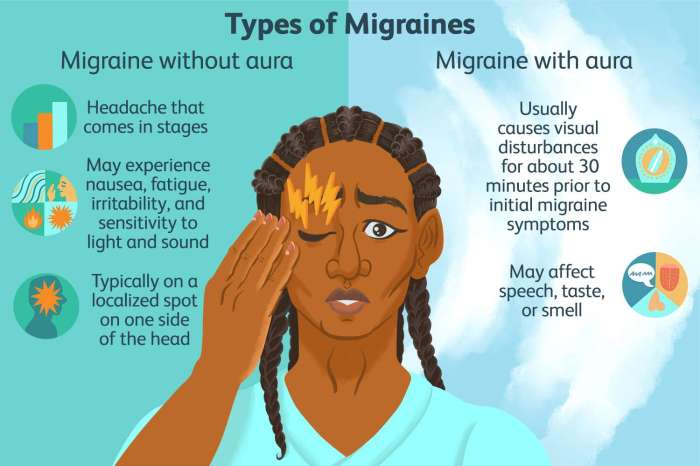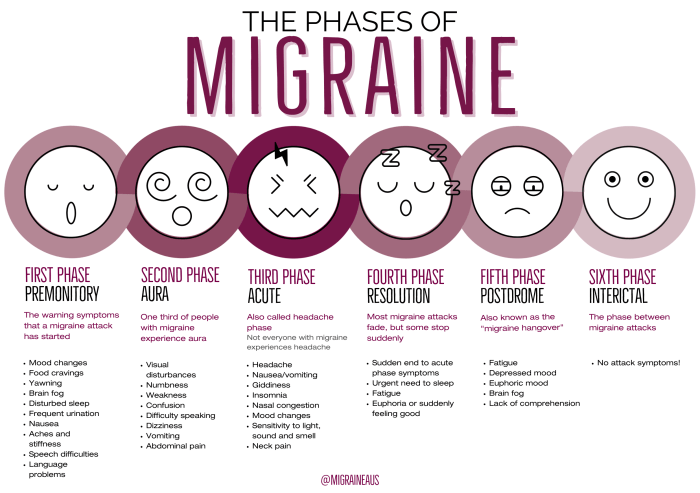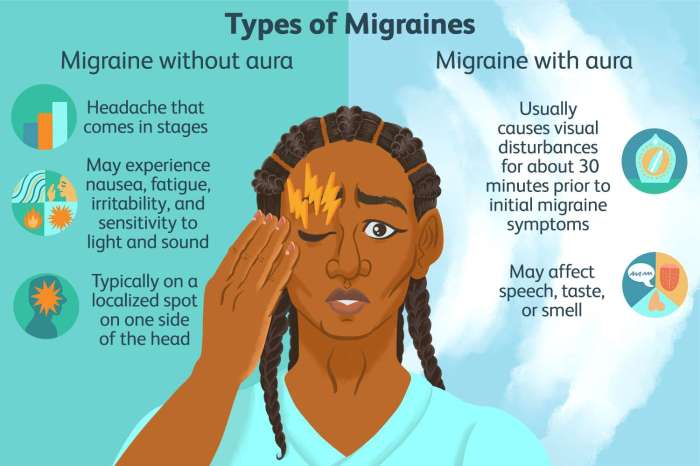Secondary headache overview and more delves into the complexities of headaches beyond the familiar. This exploration examines the crucial distinction between primary headaches, often idiopathic, and secondary headaches, where an underlying medical condition triggers the pain. Understanding the causes, symptoms, and diagnostic processes is key to effective management and treatment. Knowing how to differentiate these types is critical for seeking the right care and potentially preventing more serious complications.
This in-depth guide covers everything from common causes like infections and hemorrhages to the diagnostic tools used to pinpoint the root of the problem. It also touches on the importance of a thorough medical history, physical examination, and various tests like CT scans and MRIs. We’ll look at effective treatment strategies tailored to specific causes, from managing underlying medical conditions to pain relief.
Introduction to Secondary Headaches

Headaches are a common ailment, but they can sometimes signal a more serious underlying medical condition. Understanding the difference between primary and secondary headaches is crucial for proper diagnosis and treatment. A secondary headache is a headache that’s caused by an underlying medical problem. This distinction is important because the treatment for a secondary headache focuses on addressing the root cause, rather than just managing the pain.Primary headaches, such as tension or migraine headaches, are often treated with pain relievers and lifestyle adjustments.
However, when a headache is accompanied by other symptoms, or if it’s significantly different from a person’s usual headache pattern, it’s essential to consider the possibility of a secondary cause. Identifying this cause is critical for appropriate and effective intervention.
Distinguishing Primary and Secondary Headaches
Secondary headaches are distinguished from primary headaches by their underlying cause. Primary headaches, like migraines and tension headaches, have no identifiable medical cause. Secondary headaches, in contrast, are a symptom of an underlying medical condition. This distinction is crucial because the treatment approach differs significantly.
Comparison of Primary and Secondary Headaches
| Feature | Primary Headache | Secondary Headache |
|---|---|---|
| Cause | Unknown, often genetic or environmental factors | Underlying medical condition, such as infection, aneurysm, or tumor |
| Symptoms | Often consistent, with predictable patterns for the individual | Variable, depending on the specific underlying cause. May include other symptoms like fever, stiff neck, or neurological changes. |
| Treatment | Often focused on pain relief using over-the-counter medications, relaxation techniques, or preventive measures. | Focus on treating the underlying cause. Pain relief is a secondary consideration. |
Importance of Identifying the Underlying Cause, Secondary headache overview and more
Failing to identify the underlying cause of a secondary headache can delay appropriate treatment, potentially leading to more severe health consequences. For example, a headache accompanied by fever and stiff neck could indicate meningitis, a serious infection requiring immediate medical attention. Similarly, a sudden, severe headache could be a sign of a brain aneurysm, demanding immediate medical intervention.
Accurate diagnosis and swift action are paramount in these cases. Therefore, a thorough evaluation by a medical professional is crucial in all cases of persistent or unusual headaches.
Common Causes of Secondary Headaches: Secondary Headache Overview And More
Secondary headaches, unlike primary headaches like tension or migraine, stem from an underlying medical condition. Understanding these causes is crucial for accurate diagnosis and effective treatment, as the underlying condition needs addressing alongside the headache itself. Identifying the root cause often involves a thorough medical evaluation and potentially specialized testing.Identifying the precise cause of a secondary headache can be challenging, requiring careful consideration of the patient’s medical history, symptoms, and physical examination findings.
A thorough evaluation by a healthcare professional is essential for determining the appropriate diagnostic steps and treatment plan.
Subarachnoid Hemorrhage
Subarachnoid hemorrhage (SAH) is a life-threatening condition characterized by bleeding into the subarachnoid space, the area surrounding the brain. This bleeding frequently results in a sudden, severe headache, often described as the “worst headache of my life.” The pathophysiology involves a rupture of a blood vessel in the brain, leading to the release of blood into the cerebrospinal fluid (CSF) spaces.
The sudden increase in intracranial pressure from the blood causes the intense pain.
Meningitis
Meningitis is an inflammation of the meninges, the protective membranes surrounding the brain and spinal cord. The inflammation is frequently caused by a viral or bacterial infection. The pathophysiology of meningitis involves the immune response to the infection, which leads to the swelling and irritation of the meninges. This irritation causes the characteristic headache, often accompanied by fever and stiff neck.
Brain Tumors
Brain tumors are abnormal growths in the brain tissue. These growths can be benign or malignant, and their presence can cause a variety of symptoms, including headaches. The pathophysiology of headaches associated with brain tumors is complex, but it generally involves the tumor’s pressure on surrounding brain tissue and structures, causing pain and potentially altering intracranial pressure. Headaches from brain tumors often develop gradually, becoming more frequent and intense over time.
So, diving into secondary headaches – understanding their causes is key. But sometimes, those nagging head pains can be linked to other health factors. For example, knowing when to take a pregnancy test if you have PCOS can be crucial for figuring out the root of some symptoms. Check out this helpful guide on when to take a pregnancy test if you have PCOS for more insights.
Ultimately, a thorough evaluation by a doctor is essential for pinpointing the precise cause of secondary headaches and getting the right treatment.
Temporal Arteritis
Temporal arteritis is a form of vasculitis, an inflammation of the blood vessels. It most commonly affects the arteries in the temples, but can also affect other blood vessels in the body. The pathophysiology of temporal arteritis involves an inflammatory response that narrows the arteries, reducing blood flow to the surrounding tissues, including the brain. This can cause a severe headache, especially in the temporal area, often accompanied by jaw claudication and other systemic symptoms.
Giant Cell Arteritis
Giant cell arteritis is a form of vasculitis that can affect blood vessels throughout the body, but most commonly involves the large arteries of the head and neck. The pathophysiology of giant cell arteritis involves an inflammatory process within the artery walls, which leads to narrowing and potential rupture of the vessels. Headaches in this condition are often severe and accompanied by other symptoms, such as fever, fatigue, and vision changes.
So, you’ve got a headache, but are you sure it’s not something else? Understanding secondary headaches is key, and sometimes, figuring out if you have a cold or COVID can be a real head-scratcher. For a helpful guide on distinguishing those symptoms, check out this informative article on do i have a cold or covid. Ultimately, knowing the difference can significantly impact your treatment plan, and a proper diagnosis is always important for managing any headache.
Table: Common Secondary Headache Causes
| Symptoms | Potential Causes | Diagnostic Considerations |
|---|---|---|
| Severe, sudden headache | Subarachnoid hemorrhage | Immediate medical attention, neurological exam, CT scan |
| Gradual onset headache with fever | Meningitis | Neurological exam, lumbar puncture, blood tests |
| Progressive, worsening headache, often with neurological deficits | Brain tumor | Neurological exam, MRI or CT scan of the brain, potentially biopsy |
| Severe headache, especially in the temporal area, with jaw claudication | Temporal Arteritis | Physical examination, blood tests (ESR, CRP), temporal artery biopsy |
| Severe headache, often with systemic symptoms like fever, fatigue, and vision changes | Giant Cell Arteritis | Physical examination, blood tests (ESR, CRP), temporal artery biopsy |
Symptoms and Diagnostic Considerations
Understanding the symptoms of secondary headaches is crucial for accurate diagnosis and prompt treatment. Secondary headaches, unlike primary headaches like migraines, are often a symptom of an underlying medical condition. The specific symptoms associated with a secondary headache can vary significantly depending on the cause, making a thorough evaluation by a healthcare professional essential.Secondary headaches are often characterized by symptoms beyond the typical headache pain itself.
These additional symptoms can provide vital clues to the underlying cause. A detailed history of the symptoms, including their timing, intensity, and any associated factors, is essential for the physician to formulate an accurate differential diagnosis. This allows the healthcare professional to identify potential causes and rule out other possibilities.
Understanding secondary headaches is crucial; sometimes, they stem from underlying conditions. For example, a bladder infection can sometimes trigger a headache. If you’re experiencing a bladder infection, exploring self-treatment options like those detailed in how can i selftreat a bladder infection might help alleviate the discomfort. Fortunately, most secondary headaches have manageable causes, and with proper care, you can feel better quickly.
Knowing the potential connections between seemingly disparate conditions like bladder infections and headaches is important for better overall health.
Diverse Range of Symptoms
Secondary headaches manifest in a wide array of symptoms, extending beyond the typical headache sensations. These can include various neurological, systemic, and even psychological manifestations. The severity and duration of symptoms can differ depending on the underlying condition. For instance, a sudden, severe headache might suggest a serious issue like a stroke or subarachnoid hemorrhage, while a gradual onset of headache with accompanying fever might point towards an infection.
Variation in Symptoms Based on Cause
The nature of the symptoms can be significantly influenced by the underlying cause of the secondary headache. A headache associated with a brain tumor, for instance, might be accompanied by neurological deficits like weakness or numbness on one side of the body, along with changes in vision or speech. Headaches stemming from infections, such as meningitis, are frequently accompanied by fever, stiff neck, and potentially altered mental status.
Conversely, headaches resulting from a head injury might exhibit symptoms specific to the location and extent of the trauma.
Importance of Detailed Symptom History
A comprehensive symptom history is vital in diagnosing the underlying cause of a secondary headache. This includes not only the headache characteristics (location, intensity, duration) but also any associated symptoms. For example, if a patient reports a headache accompanied by fever, stiff neck, and nausea, the physician will consider infections as a potential cause. Likewise, if the headache is sudden and severe, with accompanying vision changes or loss of consciousness, a more serious condition should be considered.
Examples of Symptoms Associated with Different Causes
Several examples illustrate how symptoms can vary based on the underlying cause:
- Head injury: Headaches following a blow to the head might be accompanied by dizziness, nausea, vomiting, and altered mental status. The severity of the symptoms will correlate with the severity of the injury.
- Meningitis: This infection is frequently accompanied by a high fever, severe headache, stiff neck, and sometimes sensitivity to light (photophobia). A sudden onset of these symptoms is particularly concerning.
- Brain tumor: While headaches can be a symptom of a brain tumor, they are often accompanied by other neurological symptoms, such as seizures, changes in vision, or weakness in an arm or leg. The progression of symptoms can vary depending on the tumor’s location and growth rate.
Diagnostic Table
This table summarizes common symptoms and potential causes of secondary headaches:
| Symptom | Potential Causes |
|---|---|
| Severe, throbbing headache | Migraine, tension-type headache, cluster headache, aneurysm, subarachnoid hemorrhage |
| Persistent headache with fever | Meningitis, encephalitis, sinusitis, temporal arteritis |
| Headache accompanied by stiff neck | Meningitis, subarachnoid hemorrhage, brain tumor, whiplash injury |
| Headache with neurological deficits (e.g., weakness, numbness) | Stroke, brain tumor, multiple sclerosis, head injury |
Diagnostic Methods
Unraveling the cause of a secondary headache requires a systematic approach, moving beyond just the symptoms. Accurate diagnosis relies heavily on a combination of methods, each contributing a piece of the puzzle to identify the underlying issue. This process involves a careful evaluation of the patient’s medical history, a thorough physical examination, and potentially various diagnostic tests.A crucial aspect of diagnosing secondary headaches is understanding the interplay between different diagnostic tools.
Medical history and physical examination provide the initial framework, while imaging and laboratory tests offer a more in-depth look into potential causes. The combination of these methods allows for a more comprehensive understanding of the patient’s condition, guiding the physician toward the most appropriate treatment plan.
Medical History and Physical Examination
A detailed medical history is fundamental to identifying potential causes of secondary headaches. This includes inquiring about the patient’s overall health, previous illnesses, medications, substance use, and any recent stressors. Symptoms beyond the headache itself, such as fever, stiff neck, vision changes, or neurological deficits, provide crucial clues. A comprehensive physical examination is equally important. This involves assessing vital signs, including blood pressure and temperature, and conducting a neurological examination to evaluate cranial nerves, motor skills, and reflexes.
A detailed physical exam often reveals subtle signs that may point towards an underlying condition. The physical examination helps to identify any abnormalities that might suggest a specific etiology.
Imaging Techniques
Imaging plays a significant role in identifying structural abnormalities that could be causing secondary headaches. Computed tomography (CT) scans are valuable for detecting bony abnormalities, blood clots, or intracranial masses. Magnetic resonance imaging (MRI) scans provide a more detailed view of soft tissues and blood vessels, making them useful in identifying tumors, infections, or vascular malformations. The choice between CT and MRI often depends on the specific clinical situation.
Laboratory Tests
Laboratory tests are essential for identifying systemic infections, metabolic disturbances, or other underlying medical conditions that might be contributing to the headache. Blood tests can reveal markers of infection, inflammation, or certain metabolic disorders. These tests help to identify underlying systemic causes that may not be immediately apparent. For instance, elevated inflammatory markers could suggest an infection, while abnormal blood counts might indicate a blood disorder.
Neurological Examination
A neurological examination assesses the function of the patient’s nervous system. This includes evaluating cranial nerves, motor function, sensory perception, reflexes, and coordination. The examination helps determine whether the headache is associated with any neurological dysfunction. This is crucial for ruling out conditions like meningitis or stroke. The neurological examination can pinpoint specific neurological deficits, allowing for a more precise diagnosis.
Diagnostic Tests: A Summary
| Diagnostic Test | Purpose |
|---|---|
| CT scan | Detecting structural abnormalities, such as bone fractures, intracranial masses, and blood clots. |
| MRI scan | Visualizing soft tissue and blood vessels, offering a detailed view of potential abnormalities like tumors, infections, or vascular malformations. |
| Blood tests | Identifying infections, metabolic disturbances, or other systemic issues that may be contributing to the headache. |
| Neurological examination | Assessing neurological function, identifying any signs of neurological dysfunction that might be linked to the headache. |
Treatment and Management

Addressing secondary headaches requires a multifaceted approach focused on treating the underlying cause rather than just the symptoms. Effective management hinges on identifying the root cause precisely, as treating the symptom without addressing the source can lead to a recurrence or worsening of the condition. A prompt and accurate diagnosis is crucial for initiating the appropriate therapeutic strategy.Appropriate treatment for secondary headaches is essential for preventing further complications and improving overall well-being.
Failure to address the underlying cause can result in chronic pain, disability, and potentially more serious health issues. This approach prioritizes the well-being of the patient and minimizes the risk of long-term consequences.
Treating the Underlying Cause
The cornerstone of secondary headache treatment is targeting the root cause. This involves a range of interventions tailored to the specific etiology. For example, treating a headache stemming from a brain tumor necessitates surgical intervention, while a headache related to medication overuse might require medication discontinuation. The precise approach will vary greatly based on the identified cause.
Treatment Strategies for Various Causes
A diverse array of treatment strategies exists, each designed to address the specific underlying cause.
- Medication Overuse Headache: Discontinuing the offending medication is paramount. This often involves a gradual reduction in dosage, under medical supervision, to minimize withdrawal symptoms. This approach aims to allow the body to recover from the prolonged effects of the medication and restore normal pain pathways.
- Cluster Headache: Treatment options often include triptans, administered to abort ongoing attacks, and oxygen therapy. Oxygen therapy is frequently effective in mitigating the intensity and duration of cluster headaches. These therapies provide relief from acute attacks but don’t address the underlying cause of cluster headaches.
- Migraine: Migraine treatment involves both acute and preventative medications. Acute medications are used to relieve an ongoing attack, while preventative medications aim to reduce the frequency and intensity of future migraines. Strategies may include lifestyle modifications, stress management techniques, and medication to reduce the number of migraine attacks.
Summary of Common Treatment Approaches and Effectiveness
The effectiveness of treatment for secondary headaches hinges significantly on the prompt and accurate identification of the underlying cause. Treatment approaches range from discontinuing medications to managing underlying medical conditions. The overall success depends on the proper identification of the underlying condition and the subsequent implementation of a tailored treatment plan.
Comparison of Treatment Approaches
| Cause | Treatment Approach |
|---|---|
| Medication overuse headache | Discontinuation of offending medications, potentially with gradual reduction and medical supervision |
| Cluster headache | Triptans or oxygen therapy for acute relief |
| Migraine | Acute medications for symptom relief, preventative medications to reduce frequency and intensity, and lifestyle modifications |
Prevention and Prognosis
Secondary headaches, while often debilitating, are not always a permanent fixture in a person’s life. Successful management hinges on understanding the underlying cause and implementing appropriate preventive strategies. The prognosis for individuals with secondary headaches varies significantly depending on the nature of the causative condition. Early diagnosis and prompt intervention play a crucial role in improving outcomes and reducing the likelihood of long-term complications.Effective management of secondary headaches involves a multi-faceted approach that considers both medical interventions and lifestyle adjustments.
The preventive measures discussed below aim to minimize the risk of future episodes and improve overall well-being.
Preventive Strategies for Reducing Secondary Headache Risk
Addressing the root cause of the secondary headache is paramount to preventing future occurrences. This often involves treating the underlying medical condition, whether it’s a sinus infection, a vascular abnormality, or another ailment. Lifestyle changes can also significantly reduce the frequency and severity of secondary headaches.
Prognosis Based on Underlying Cause
The prognosis for secondary headaches is contingent upon the underlying cause. Conditions like migraine, tension-type headaches, and cluster headaches are primary headaches and do not stem from an underlying medical condition. Secondary headaches, in contrast, stem from a variety of medical problems. A brain tumor, for instance, carries a considerably different prognosis compared to a simple dental infection.
The severity of the underlying condition and the promptness of diagnosis and treatment greatly influence the outlook. For example, timely intervention in cases of intracranial hemorrhage can significantly improve the chances of recovery, while delaying treatment can lead to severe neurological impairments or even fatality. The specific prognosis for each case needs to be evaluated individually by a healthcare professional.
Importance of Early Diagnosis and Intervention
Early diagnosis and intervention are critical in managing secondary headaches. Prompt medical attention can help identify and treat the underlying cause, preventing further complications. A delay in diagnosis could lead to worsening of the underlying condition, leading to more serious health issues. For example, if a brain tumor is diagnosed late, its growth could result in irreversible neurological damage.
Lifestyle Changes to Prevent Secondary Headaches
Lifestyle adjustments can play a significant role in reducing the likelihood of secondary headaches. Maintaining a consistent sleep schedule, managing stress effectively, and eating a balanced diet are all important components of a preventative strategy.
Preventive Measures for Secondary Headaches
- Regular Exercise: Physical activity helps reduce stress, improve circulation, and maintain a healthy weight. This is crucial for overall well-being and can indirectly help in reducing the likelihood of secondary headaches.
- Stress Management Techniques: Chronic stress can trigger or exacerbate headaches. Techniques like meditation, yoga, and deep breathing exercises can help manage stress and potentially prevent headaches.
- Maintaining a Healthy Diet: A balanced diet rich in fruits, vegetables, and whole grains can provide essential nutrients and support overall health, potentially reducing the risk of headaches.
Outcome Summary
In conclusion, secondary headaches, while potentially debilitating, are treatable when the underlying cause is identified. This overview emphasizes the importance of recognizing the differences between primary and secondary headaches, understanding the various causes, and utilizing the appropriate diagnostic tools. Early diagnosis and intervention are crucial to successful management and improved prognosis. By grasping the complexities of secondary headaches, individuals can better navigate the healthcare journey towards a healthier outcome.




